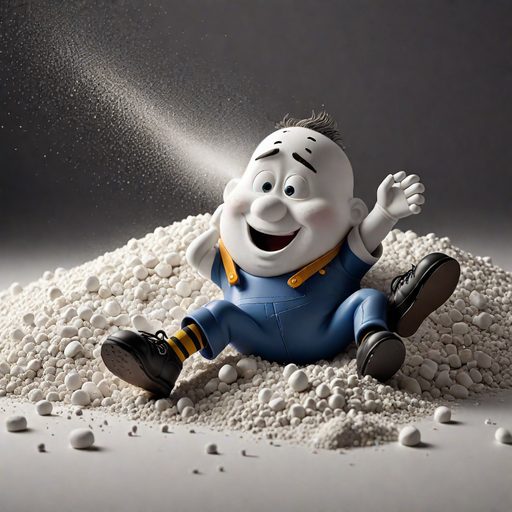
Talc: Is There a Link to Cancer? WHO Investigates
Recommended for Public Safety
Hey curious enthusiasts, you’ve probably heard of talc powder, right? It’s that super fine, silky smooth powder that’s been used in baby powder and a bunch of other cosmetics for ages. It’s everywhere, and most of us have probably used it at some point.
But here’s the thing: the World Health Organization (WHO), just dropped a bit of a bombshell. Their cancer research arm, the IARC, has now labeled talc as “probably carcinogenic to humans.” That’s a pretty big deal, and it definitely raises some eyebrows about the safety of this seemingly harmless powder.
This classification doesn’t mean that every sprinkle of talc is going to give you cancer. It’s based on a bunch of studies, some showing a potential link to ovarian cancer, but the evidence isn’t rock-solid yet. It’s a bit of a grey area, and scientists are still trying to figure out the exact risks.
But the fact that the WHO is raising this red flag is definitely something to take seriously. So, stay tuned, because this is a topic that’s super relevant to a lot of us, and it’s important to get the facts straight. We’ll break it down for you, simple and clear, so you can make the best choices for yourself and your loved ones.
What is World Health Organization (WHO)?
The World Health Organization (WHO) is a specialized agency of the United Nations responsible for international public health. Established in 1948, it coordinates global efforts to promote health, prevent disease outbreaks, and improve access to healthcare.
What is Carcinogenic?
Carcinogenic refers to a substance, organism, or agent that is capable of causing cancer. These agents can be natural (like ultraviolet radiation) or man-made (like cigarette smoke).
What is World Health Organization's cancer agency (IARC)?
The International Agency for Research on Cancer (IARC) is the specialized cancer agency of the World Health Organization (WHO). IARC’s mission is to conduct and coordinate research into the causes of cancer to inform preventive measures and reduce the global cancer burden.
What is Ovarian cancer?
Ovarian cancer is a type of cancer that starts in the ovaries, the female reproductive organs responsible for producing eggs. It occurs when abnormal cells in the ovaries multiply uncontrollably, forming a tumor. If left untreated, the cancer can spread to other parts of the body.
Key Facts:
-
Observational Studies in Humans: Researchers have seen studies where women who used talc had a higher risk of ovarian cancer. But, there’s a catch – some of this talc might have been contaminated with asbestos, a known carcinogen that’s sometimes found near talc deposits. So, it’s hard to say if it was the talc itself or the asbestos causing the issue.
-
Animal Studies: In rats, the link is clearer. Exposing them to talc led to the development of tumors. This is concerning, but remember, rats aren’t humans, so it’s not a direct one-to-one comparison.
-
Lab Studies on Human Cells: This is where things get interesting. Scientists have seen that talc can damage DNA and cause inflammation in human cells – both of which are major red flags when it comes to cancer development.
-
So, does all this mean talc is definitely causing cancer? Not quite. The IARC classification is “probably carcinogenic,” meaning the evidence isn’t rock-solid yet. It’s more like a strong suspicion based on multiple lines of evidence.
-
Adding to the complexity, there’s conflicting information out there. A massive study in 2020 with 250,000 women found no link between talc and ovarian cancer. And, Johnson & Johnson, the talc-powder giant, recently paid a huge settlement over safety claims. So, there’s a lot of debate and uncertainty.
Conclusion:
For now, it’s wise to be cautious. If you’re concerned, limit your talc use. There are plenty of talc-free alternatives out there. And, most importantly, keep an eye on the research as it develops. The science is still evolving, and we’ll get a clearer picture of the risks as time goes on.
Watch a video
Softness or Sickness? Unmasking the Risks of Talcum Powder.
Curious Times is a leading newspaper and website for kids. We publish daily global news aligned to your learning levels (also as per NEP 2020): Foundational, Preparatory (Primary), Middle and Senior. So, check out the News tab for this. We bring kids’ favourite Curious Times Weekly newspaper every weekend with top news, feature stories and kids’ contributions. Also, check out daily JokesPoke, Tongue Twisters, Word of the Day and Quote of the Day, kids need it all the time.
Curious Times News Program for Schools for FREE. Over 5,000 schools and teachers from all over the world have joined our programme so that students and teachers can get FREE Educative Newspaper. Here, kids can take part in world events and win prizes and certificates for free through their schools.
Moreover, schools are sharing important School News, like interviews with the principal, notices about new students, contests, and results, not just on social media but also on a news website for kids and other schools.
Thus, do not wait any further, sign-up for your school for FREE.
The following social media platforms allow you to communicate with us: WhatsApp, Instagram, Facebook, Youtube, Twitter, and LinkedIn.
0 (Please login to give a Curious Clap to your friend.)
